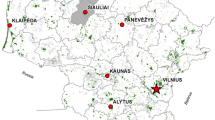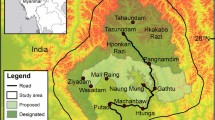Abstract
In the tropics and sub-tropics, where high levels of biodiversity co-exist with some of the greatest levels of population density, achieving complete exclusion in protected area contexts has proved close to impossible. There is a clear need to recognize that parks are significantly impacted by human–environment interactions in the larger landscape within which they are embedded, and to move the frontier of research beyond the boundaries of protected areas in order to examine larger landscapes where multiple forms of ownership and access are embedded. This research evaluates forest change and fragmentation between 1990 and 2000, in a landscape surrounding the Mahananda Wildlife Sanctuary in the Indian state of West Bengal. This protected forest is bounded to the south by a less intensively protected area, the Baikunthapur Reserve Forest, and surrounded by a mosaic of unprotected, largely private land holdings. Results indicate differences in the extent and spatial pattern of forest cover change in these three zones, corresponding to different levels of government protection, access and monitoring. The two protected areas experience a trend toward forest regrowth, relating to the cessation of commercial logging by park management during this period. Yet, there is still substantial clearing toward peripheral areas that are well connected to illegal timber markets by transportation networks. The surrounding landscape, although experiencing some forest regrowth within less intensively cultivated tea plantations, is also becoming increasingly fragmented, with potentially critical impacts on the maintenance of effective wildlife corridors in this ecologically critical region.


Similar content being viewed by others
References
Bawa KS, Raven PH, Seidler R (2004) Reconciling conservation paradigms. Conservation Biology 18:859–860
Bist SS (2002) An overview of elephant conservation in India. The Indian Forester 128:121–136
Bruner AG, Gullison RE, Rice RE, da Fonseca GAB (2001) Effectiveness of parks in protecting tropical biodiversity. Science 291:125–128
Chakrabarti M, Sarkar A, Ghosh SR, Sarkar A (2002a) Forest structure, resource use and institutions: experiences from Salugarah (Fapri), Baikunthapur Forest Division. Centre for Studies in Rural Economy, Appropriate Technology and Environment. St. Joseph’s College, Darjeeling, India
Chakrabarti M, Sarkar A, Ghosh SR, Sarkar A (2002b) Forest structure, resource use and institutions: site report from Dabgram, Baikunthapur Forest Division. Centre for Studies in Rural Economy, Appropriate Technology and Environment. St. Joseph’s College, Darjeeling, India
Chapin M (2004) A challenge to conservationists. World Watch Nov/Dec: 17–31
Cincotta RP, Engelman R (2000) Nature’s place: human population and the future of biological diversity. Population Action International, Washington DC, USA
Das TK, Guha I (2003) Economics of man-animal conflict: a lesson for wildlife conservation. ACB Publications and DSA Centre for Regional Economic Studies, Jadavpur University, Kolkata, India
DeFries R, Hansen A, Newton AC, Hansen MC (2005) Increasing isolation of protected areas in tropical forests over the past twenty years. Ecological Applications 15:19–26
DeFries R, Hansen A, Turner BL, Reid R, Liu J (2007) Land use change around protected areas: management to balance human needs and ecological function. Ecological Applications 17:1031–1038
Forman RTT (1995) Land mosaics: the ecology of landscapes and regions. Cambridge University Press, Cambridge, UK
Fox J, Rindfuss RR, Walsh SJ, Mishra V (2003) People and the environment: approaches for linking household and community surveys to remote sensing and GIS. Kluwer Academic Publishers, Boston, MA
Government of India (1992) Final population totals. Census of India 1991, Office of the Registrar General, New Delhi
Government of India (2001) Data from the 2001 Census, including cities, villages and towns. Census Commission of India, New Delhi
Haines-Young R, Chopping M (1996) Quantifying landscape structure: a review of landscape indices and their application to forested landscapes. Progress in Physical Geography 20:418–445
Hansen AJ, DeFries R (2007) Ecological mechanisms linking protected areas to surrounding lands. Ecological Applications 17:974–988
IIFM (Indian Institute of Forest Management, Bhopal) (2001) Public forests, fuelwood collection and migration: a case study in North Bengal. Food and Agricultural Organization of the United Nations Regional Wood Energy Development Programme in Asia, Bangkok, Thailand
Jensen JR (2000) Remote sensing of the environment: an earth resource perspective. Prentice Hall, New Jersey, USA
Liverman D, Moran EF, Rindfuss RR, Stern PC (eds) (1998) People and pixels: linking remote sensing and social science. National Academy Press, Washington DC, USA
Madhusudhan MD (2005) Of rights and wrongs: wildlife conservation and the tribal bill. Economic and Political Weekly 40:4893–4896
McGarigal K, Cushman SA, Neel MC, Ene E (2002) FRAGSTATS: spatial pattern analysis program for categorical maps. Computer software program produced by the authors at the University of Massachusetts, Amherst. Available at www.umass.edu/landeco/research/fragstats/fragstats.html
Moran EF, Ostrom E (eds) (2005) Seeing the forest and the trees: human-environment interactions in forest ecosystems. MIT Press, Cambridge, Massachusetts, USA
Munroe DK, Nagendra H, Southworth J (2007) Monitoring landscape fragmentation in an inaccessible mountain area: Celaque National Park, Western Honduras. Landscape and Urban Planning 83:154–167
Nagendra H (2008) Do parks work? Impact of protected areas on land cover clearing. AMBIO: A Journal of the Human Environment 37:330–337
Nagendra H, Southworth J, Tucker CM (2003) Accessibility as a determinant of landscape transformation in Western Honduras: linking pattern and process. Landscape Ecology 18:141–158
Naughton-Treves L, Holland MB, Brandon K (2005) The role of protected areas in conserving biodiversity and sustaining local livelihoods. Annual Review of Environment and Resources 30:219–252
Nepstad D, Schwartzman S, Bamberger B, Santilli M, Ray D, Schlesinger P, Lefebvre P, Alencar A, Prinz E, Fiske G, Rolla A (2005) Inhibition of Amazon deforestation and fire by parks and indigenous lands. Conservation Biology 20:65–73
NESPON (North Eastern Society for Preservation of Nature and Wildlife) (2000) State of north Bengal’s forests: Background paper. In: Discussion on combating deforestation: the question of rural development in forest areas of North Bengal, March 17, Siliguri Tathyakendra, West Bengal, India
Ostrom E, Nagendra H (2006) Insights on linking forests, trees, and people from the air, on the ground, and in the lab. Proceedings of the National Academy of Sciences of the United States of America 103:19224–19331
Peralta P, Mather P (2000) An analysis of deforestation patterns in the extractive reserves of Acre, Amazonia from satellite imagery: a landscape ecological approach. International Journal of Remote Sensing 21:2555–2570
Petit C, Scudder T, Lambin E (2001) Quantifying processes of land-cover change by remote sensing: resettlement and rapid land-cover changes in south-eastern Zambia. International Journal of Remote Sensing 22:3435–3456
Ray TN (1996) History of forest management in North Bengal. West Bengal Forests Centenary Commemoration
Rindfuss RR, Walsh SJ, Turner BL III, Fox J, Mishra V (2004) Developing a science of land change: challenges and methodological issues. Proceedings of the National Academy of Sciences of the United States of America 101:13976–13981
Robbins PF, Chhangani AK, Rice J, Trigosa E, Mohnot SM (2007) Enforcement authority and vegetation change in Kumbhalgarh Wildlife Sanctuary, Rajasthan, India. Environmental Management 40:365–378
Rodrigues ASL, Andelman SJ, Bakarr MI, Boitani L, Brooks TM, Cowling RM, Fishpool LDC, da Fonseca GAB, Gaston KJ, Hoffmann M, Long JS, Marquet PA, Pilgrim JD, Pressey RL, Schipper J, Sechrest W, Stuart SN, Underhill LG, Waller RW, Watts MEJ, Yan X (2004) Effectiveness of the global protected area network in representing species diversity. Nature 428:640–643
Schwartzman S, Moreira A, Nepstad D (2000) Rethinking tropical forest conservation: perils in parks. Conservation Biology 14:1351–1357
Shahabuddin G, Rangarajan M (eds) (2007) Making conservation work: securing biodiversity in this new century. Permanent Black, Ranikhet, India
Shankar U (2001) A case of high tree diversity in a sal (Shorea robusta)-dominated lowland forest of Eastern Himalaya: floristic composition, regeneration and conservation. Current Science 81:776–786
Sokal RR, Rohlf FJ (1981) Introduction to biostatistics, 2nd edn. Island Press, Washington DC, USA
Southworth J, Nagendra H, Munroe DK (2006) Introduction to the special issue: are parks working? Exploring human-environment tradeoffs in protected area conservation. Applied Geography 26:87–95
Terborgh J, van Schaik C, Davenport L, Rao M (eds) (2002) Making parks work: strategies for preserving tropical nature. Island Press, USA
Thomlinson JR, Bolstad PV, Cohen WB (1999) Coordinating methodologies for scaling landcover classifications from sitespecific to global: steps towards validating global map products. Remote Sensing of the Environment 70:16–28
Wildlife Circle (1997) Management plan of Mahananda Wildlife Sanctuary. Government of West Bengal, West Bengal
Acknowledgments
We thank the West Bengal Forest Department for permissions for field studies, and for their valuable inputs and feedback on our research. We also thank the local forest users and residents who generously assisted us with our enquiries. Financial support from the National Science Foundation to CIPEC, from a National Geographic Society Conservation Trust Grant, and from a Society in Science—Branco Weiss Fellowship—to Harini Nagendra is gratefully acknowledged.
Author information
Authors and Affiliations
Corresponding author
Rights and permissions
About this article
Cite this article
Nagendra, H., Paul, S., Pareeth, S. et al. Landscapes of Protection: Forest Change and Fragmentation in Northern West Bengal, India. Environmental Management 44, 853–864 (2009). https://doi.org/10.1007/s00267-009-9374-9
Received:
Accepted:
Published:
Issue Date:
DOI: https://doi.org/10.1007/s00267-009-9374-9




